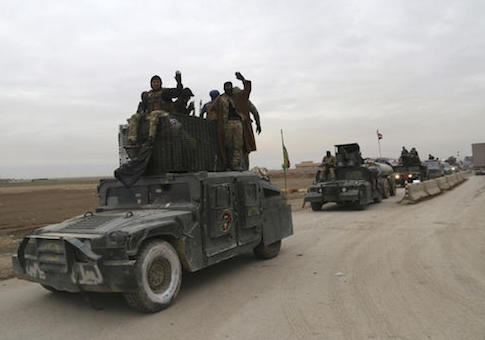A shift in strategy combining a troop surge with increased coordination of artillery and air power has driven ISIS terrorists from their strongholds on the eastern bank of the Tigris river in the strategic city of Mosul, Iraq.
American and allied aircraft, alongside U.S. advisers and thousands of Iraqi soldiers and police, have won the first phase of a campaign to retake the most populous city in northern Iraq.
Col. John Dorrian of the U.S.-led Combined Joint Task Force said in an exclusive interview with the Washington Free Beacon that the new strategy, which was put into effect at dawn on Dec. 29 and continues to this day, is the reason coalition forces have been victorious over the past four weeks.
The Iraqi government announced Jan. 24 that it had full control of east Mosul. Liberating west Mosul may be easier because of lessons learned, U.S. and Iraqi officials said.
These gains came after two brutal months for Iraqi troops in November and December 2016. Some 2,000 Iraqi troops were killed in November, according to estimates from the United Nations. Iraqi units suffered casualty rates as high as 30 percent in December, according to various published reports.
Counter-terrorism troops suffered a major setback after the Iraqi Army seized the Al Salam Hospital complex in East Mosul on Dec. 6, 2016. The hospital had been used as a headquarters by ISIS. Conflict broke out between hundreds of ISIS militants and elite counter-terrorism forces following a string of car and truck bombs detonated in the Iraqi forces' front lines. Dozens of counter-terrorism forces reportedly were killed or wounded in the fighting. The intensity of the fighting forced the Iraqi army to pull back.
While that battle resulted in a temporary setback, lessons were learned and a new strategy was born from it.
"The Coalition increased the number of advisers in Mosul by about 40, to begin advising the Iraqi Federal Police for the first time," Dorrian said.
Increased coordination allowed for synchronized attacks carried out by the Iraqi Army, Iraqi Federal Police, and Iraqi Counter-Terrorism Service, according to Dorrian.
Additionally, coalition forces provided aircraft to destroy terrorist strongholds and provide overhead surveillance and intelligence on enemy movements.
Coordinated ground attacks and punishing airstrikes contributed to the slow but steady decline of ISIS in the area. Each day, ISIS lost more than 20 fighters. The terror group was pushed out of the entire eastern half of Mosul by mid-January, though mop-up operations continued through the end of the month. The Iraqi Army held a victory press conference on Jan. 18, and the Iraqi government announced on Jan. 24 it had full control of east Mosul.
Now, Iraqi counter-terrorism forces are poised to strike inside west Mosul, across the Tigris River from the newly freed portion of Mosul.
Iraq's Ministry of Defense reported Jan. 25 that the Islamic State lost half of its manpower in the area during the east Mosul battles.
The Iraqi army may pause in east Mosul to regroup and reposition its forces before the final phase of the campaign, according to a general leading Iraq's elite Golden Division, a 10,000-man force at the forefront of the assault on Mosul from Oct. 17 onward.
"We may hold up for several days to make a good plan for the final attack," said Lt. Gen. Abdul Ameer Yarallah to Allen Kakony, an freelance war reporter who relayed the conversation to the Free Beacon. "Or we may shoot at them in a week. When we hit them, it will be a surprise."
